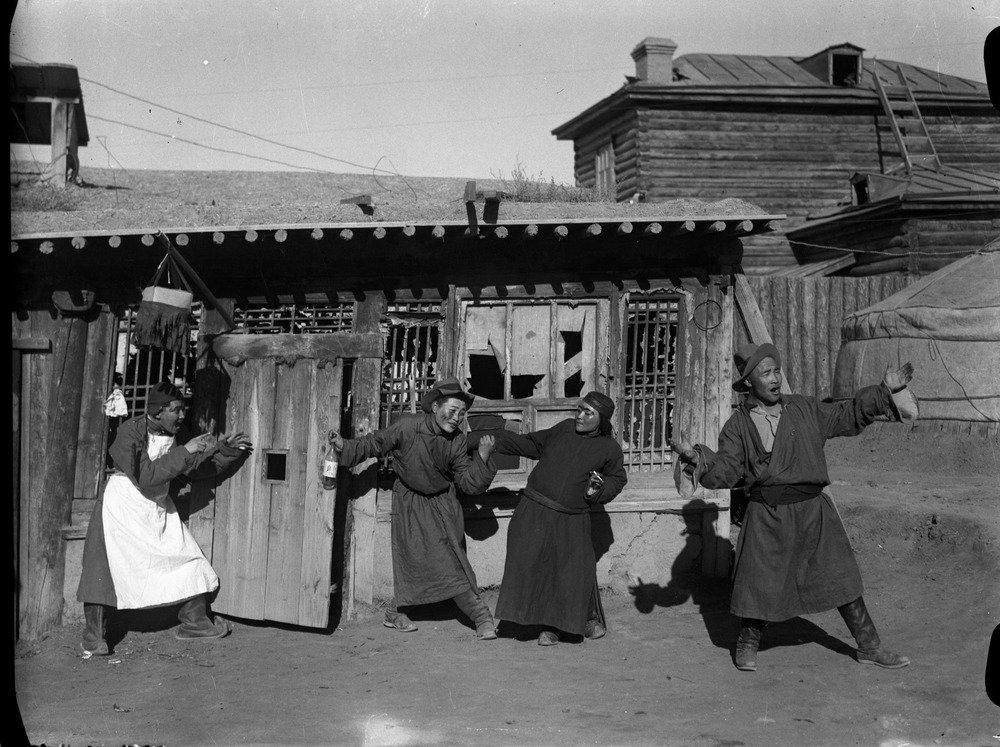The main goal of the Soviets was to launch the class struggle in Mongolia and follow Stalin’s model of the “complete elimination of the kulak class”. The Soviet planned to create a united front or poor people against the lamas, noblemen and other feudal and chose the MPRP and the Mongolian Union of Revolutionary Youth to accomplish this task. A recruitment campaign for MPRP Party members was launched and this organization, which was called upon to fight the feudal regime, enrolled more than 40,000 new members. Within two years the Party’s membership had increased fivefold. A large-scale campaign to confiscate the property of “the black and yellow feudals” (the nobles and lamas) was launched. A plan to “neutralize” these “elements” was also begun. But at this time the Mongolian leaders were split over how to deal with the official instructions. One group headed by Shijee and Badrah argued for carrying out the instructions exactly, while the group, including Genden and Demid, feared that the unstable external situation might lead to an anti-revolutionary rebellion.
Confiscating Property
According to earlier research conducted by the Comintern, 4.1 percent of Mongolia’s population and 45.1 percent of the total livestock population were classified as “feudal”. According to the research, the number of feudals or kulaks possessing more than 500 head of cattle was now half of what it had been in 1924, “as a result of revolutionary measures”, and the number of their animals had been reduced by 20 percent. This reduction was still too small for the Comintern, so it demanded that more decisive measures be taken. At the instruction of the Soviet Union, the Mongolian Government declared open warfare against livestock breeders. The Fifth State Ih Hural passed a decision to confiscate the property of feudals. The property confiscation commission was set up, with Choibalsan as its Chairman, and its plan was approved on July 13, 1929. A month later the presidium of the MPRP Central Committee and the Central Auditing Commission passed a decision to intensify the campaign and bring it to completion quickly.
That campaign of the robbery was carried out very thoroughly across the country and households were left with just 300 togrogs worth of property regardless of the number of family members. In the early 1930s, Choibalsan delivered a report on the campaign to the Eighth Congress of the MPRP. According to the report, 5.2 million togrog worth of property was confiscated. At that time, a cow costs about 50 togrogs. Everything was confiscated, including animals, houses, gold, silver, jewelry, clothes, religious items, handicrafts, furniture, and so on. A lot of wealthy people fell victim to that robbery.
Robbing the Mongols
The Soviets were not satisfied with the first campaign of confiscation, so they started a second one, expressly saying that it should not look like the second campaign for confiscating capital. The court system and the Internal Security Office were instructed to carry out this work and finish before the end of 1931. The campaign, which was carried out under the name of “confiscating hidden property”, coincided with massive numbers of arrests and imprisonments. In the first half of 1931, 384,480 togrog worth of property was confiscated from forty-seven economic units. Still more was demanded, so in the second half of the year, the campaign of confiscating was intensified, 137 people were called before the court and more than 1.1 million togrogs worth of property was confiscated. The campaign was stepped up yet again and, over the next three months, 5191 people were jailed at the Central Prison alone.
According to incomplete data 9.7-10 million togrog worth of property was confiscated by the spring 1932. there is other evidence that, in the period between 1929 and 1932, property was confiscated from 1564 economic units. But it also is interesting to consider where such a large amount of confiscated property is said to have gone. One source says that, “out of 5,222,567 togrog and 72 Mongo worth of property 1,703,640 togrog worth was transferred to the poor, and other property and animals was distributed to 130 collective farms”. Although there was no natural calamity, the natural wealth of Mongolia- the livestock population- was reduced by one third in 1932 compared to its 1929 levels.
The Struggle Against Religion Truggle Against Religion
Another target, of the Soviets’ attack was the temples and monasteries. From the beginning, religion was considered the main ideological enemy of the communists. At that time, 14-15% of the main wealth of Mongolia, its livestock, was the property of the monasteries and temples. The Soviets thought of using an interesting from of robbery called the “has campaign”, instead of directly confiscating the monks animals. The revolutionaries, who knew the property of the monasteries consisted of more than livestock, enforced a tax policy.
The impossibly heavy taxes placed a great burden on the monasteries and emptied them almost immediately. According to the “contract”, they not only taxed the livestock they had already confiscated, but they taxed other properties such religious statue. The taxes varied from the military to budget. The monks given a choice of whether to pay up or go to prison. The purpose of this tax policy was to bankrupt the rich lamas and force the poor monks to abandon their religion.
Influential religious figures were being captured and executed. Zay bandid Hutagt, Erdene bandid Hutagt and Hamba Nomun Hutagt, Bigeriin Nomun Khan and Yalguulsan Hutagt from zasagt Khan image, and Huuhen Hutagt from tsetsen Khan aimag were all executed.

